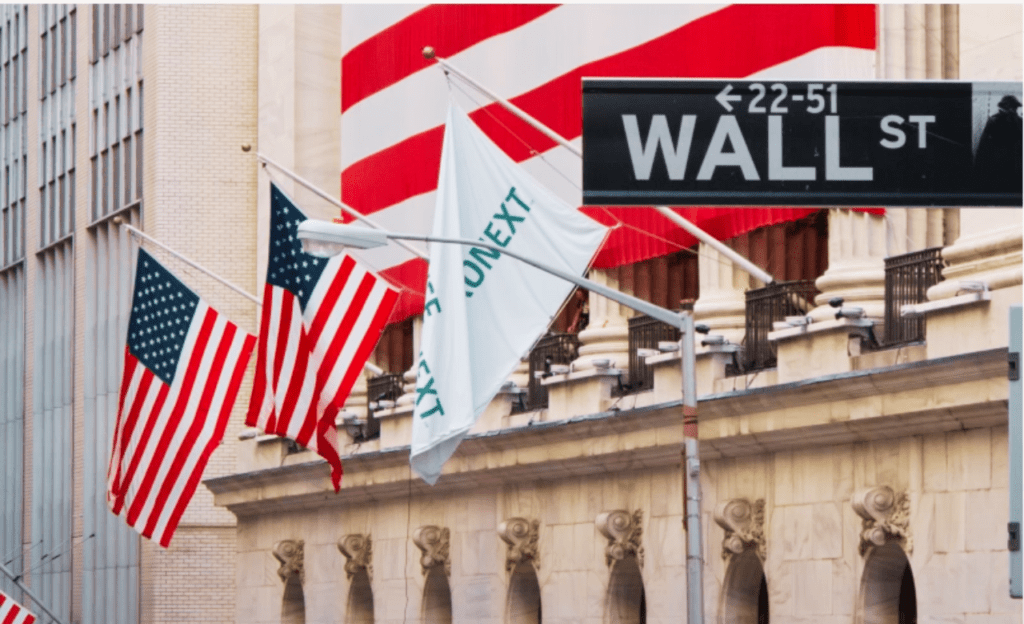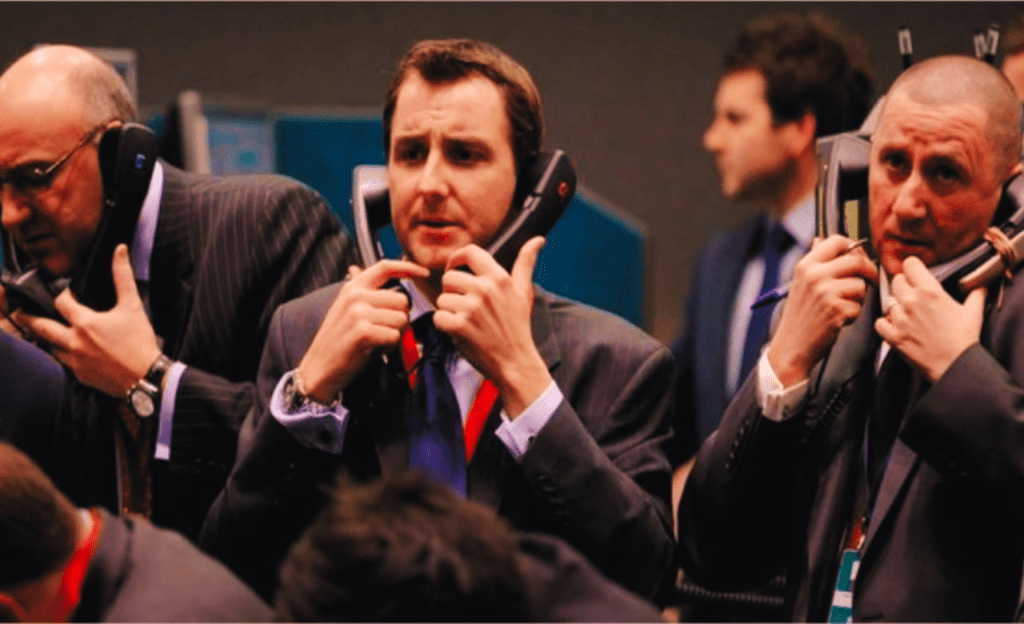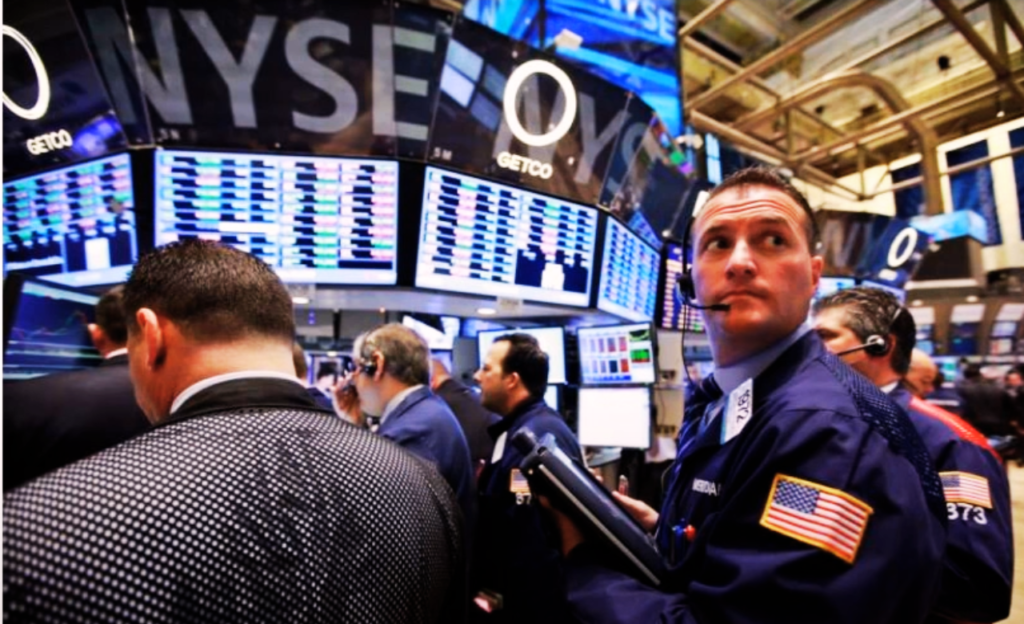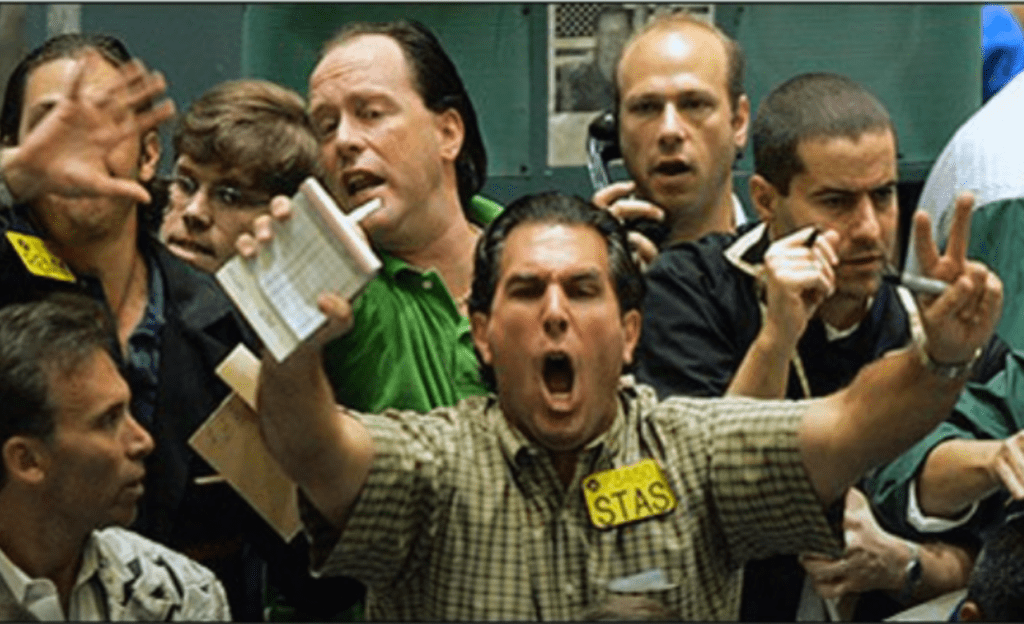
The New York Stock Exchange (NYSE), famously known as “The Big Board,” stands as a cornerstone of American finance within the Financial District of Lower Manhattan, New York City. This iconic stock exchange holds the distinction of being the largest in the world when measured by market capitalization. Let’s dive into the history, significance, and evolution of the NYSE.
Table of Contents
The NYSE’s Historic Significance
The NYSE’s Architectural Marvel
Situated at the junction of 11 Wall Street and 18 Broad Street, the NYSE’s trading floor is housed in the illustrious New York Stock Exchange Building. This structure, along with the previous trading room located at 30 Broad Street, collectively carries the legacy of the financial world’s transformation. The former trading room, however, closed its doors in February 2007, leaving its mark on the history of the NYSE.
A National Historic Landmark
The NYSE’s trading floor is not only a bustling hub of financial activity but also a designated National Historic Landmark. This status reflects the profound impact the exchange has had on American finance and the global economy throughout its storied history.
Ownership and Evolution
Transition of Ownership
The NYSE finds its ownership under the umbrella of Intercontinental Exchange (NYSE: ICE), an American holding company that is also listed on the exchange. A significant step in its journey was the merger with Euronext in 2007, forming NYSE Euronext (NYX). The NYSE’s continuous evolution speaks to its adaptability in a dynamic financial landscape.
The NYSE’s Enduring Influence

A Gallup Poll Insight
According to a recent Gallup poll conducted in 2022, a staggering 58% of American adults have investments in the stock market. These investments encompass individual stocks, mutual funds, and retirement accounts, showcasing the widespread impact and relevance of the NYSE in people’s financial lives.
Tracing the Origins
The Buttonwood Agreement
The earliest seeds of securities trading in New York were sown with the Buttonwood Agreement. This historic pact, signed on May 17, 1792, united 24 brokers who established a standardized commission rate and pledged mutual support in securities sales. This agreement laid the foundation for a structured securities market.
Evolution and Reform
In 1817, under the aegis of the Buttonwood Agreement, New York’s stockbrokers initiated reforms and reorganization. Observing the governance model of Philadelphia’s board of brokers, they introduced measures against manipulative trading and established formal governing bodies. This led to the formation of the New York Stock and Exchange Board, which subsequently evolved into the NYSE.
Rise to Prominence
The advent of the electrical telegraph was a transformative moment for the market, catapulting New York’s financial standing above that of Philadelphia. The NYSE’s Open Board of Stock Brokers emerged as a strong competitor, ultimately merging with the NYSE in 1869. This consolidation bolstered the NYSE’s reputation for liquidity and efficiency.
Navigating Challenges and Change
Steadfast Amid Turbulence
The NYSE’s history includes instances of market panics and crashes, often leading to the realization of the need for government regulation. A significant turning point was the 1930s, when the aftermath of a major stock market crash triggered the Great Depression. These challenges prompted the NYSE to implement enhanced shareholder protection measures, such as the restriction of brokers from voting uninstructed shares in 2012.
Unveiling the Legacy: The Stock Exchange Luncheon Club and the Evolution of NYSE

The Historic Stock Exchange Luncheon Club
Discovering a Culinary Haven
Perched on the seventh floor, the Stock Exchange Luncheon Club carved a unique niche in the history of the New York Stock Exchange (NYSE). From its establishment in 1898 to its eventual closure in 2006, this culinary retreat played host to the financial elite, providing more than just a meal—it was a hub of networking and camaraderie.
NYSE’s Transformation: From Merger to For-Profit
A Strategic Shift for the NYSE
In a pivotal move, the NYSE unveiled its intent to merge with Archipelago on April 21, 2005. The primary goal was to reimagine the NYSE as a publicly traded entity. The board’s decisive vote on December 6, 2005, paved the way for a transformation into a for-profit, public company. Trading under the banner NYSE Group commenced on March 8, 2006.
The Birth of NYSE Euronext: A Transatlantic Partnership
A Transatlantic Milestone
On April 4, 2007, a historic merger with Euronext, the European combined stock market, culminated in the birth of NYSE Euronext. This groundbreaking union marked the first transatlantic stock exchange, a testament to the global reach and influence of the NYSE.
Wall Street: Epicenter of Financial Activity
Unraveling the Essence of Wall Street
Wall Street, often dubbed the epicenter of international financial activities, occupies a preeminent role in the realm of wholesale financial services. Embracing a matrix of sectors, markets, institutions, and industry firms, it encompasses the securities industry, commercial banking, asset management, and insurance, making it a powerhouse of economic influence.
Leadership and Evolution
Captains of NYSE
Formerly helmed by Marsh Carter and Duncan Niederauer, the NYSE experienced a transition in leadership. Presently, Jeffrey Sprecher holds the chairmanship, steering the NYSE’s course. The metamorphosis of leadership reflects the exchange’s adaptability in a dynamic financial landscape.
Shaping the 20th Century: NYSE’s Resilience
Navigating Turbulence
The NYSE’s history is punctuated by significant events that tested its resilience. The exchange’s closure during World War I was followed by a partial reopening to support the war effort. The Wall Street bombing of 1920 stands as a somber reminder of challenges faced by the financial district.
Challenges and Triumphs
A Rollercoaster Century
The Black Thursday crash of 1929, often attributed to the Great Depression, brought about comprehensive reforms aimed at investor protection. The NYSE’s registration as a national securities exchange in 1934 signaled a pivotal regulatory step.
The 20th Century’s Impact
Trials and Triumphs
The NYSE faced more challenges, including the 1987 Black Monday crash and subsequent mini-crashes. The 1989 Mini-Crash and the Asian Financial Crisis of 1997 underscored the exchange’s susceptibility to global financial shifts.
New York stock exchange coin
A Legacy of Adaptability
Through a century marked by volatility, the NYSE remains a testament to adaptability and resilience. Its journey, from the Stock Exchange Luncheon Club’s exclusive gatherings to its transatlantic partnership and role in global finance, encapsulates the spirit of innovation that defines Wall Street.
Navigating the 21st Century: Unveiling the NYSE’s Trials and Triumphs

A Century of Challenges and Progress
The New York Stock Exchange (NYSE), an icon of financial might, has traversed the 21st century amid a series of trials and triumphs. Let’s explore the pivotal moments that have shaped the exchange’s narrative in recent decades.
A Confrontation Amid Artistry: 2000 Altercation
A Clash of Creativity and Finance
In the year 2000, the NYSE found itself embroiled in an unexpected event during the filming of Rage Against the Machine’s “Sleep Now in the Fire” music video. Directed by Michael Moore, the altercation led to a temporary closure of the exchange’s doors and the band’s escort from the premises. This intersection of art and finance left an indelible mark on the exchange’s history.
Resilience Amid Tragedy: Aftermath of 9/11
Weathering the Storms of Terror
The seismic impact of the September 11 attacks reverberated across the NYSE. The exchange stood united in the face of adversity, closing its doors for an unprecedented four trading sessions. The resilience displayed during this challenging period marked a defining moment for the NYSE.
The 2010 Flash Crash: A Moment of Instability
An Intriguing Plunge and Recovery
May 6, 2010, etched an intriguing episode in the NYSE’s history with the Dow Jones Industrial Average experiencing a significant intraday percentage drop. Widely known as the 2010 Flash Crash, the event saw a 998-point loss before swift rebounding. Regulatory efforts sought to decipher the cause, though conclusive answers remained elusive.
Hurricane Sandy’s Wrath: A Pause in 2012
Nature’s Fury Tests the NYSE
Hurricane Sandy, a force of nature, cast its shadow over the NYSE in 2012. The stock exchange succumbed to the elements, shutting its doors for two days. The echoes of history intertwined with the past, recalling the last time weather-induced closure occurred for a full two days in 1888.
Navigating Regulatory Waters: A 2014 Fine
A Financial Penalty and Regulatory Vigilance
In 2014, the NYSE faced the implications of regulatory oversight. A fine of $4.5 million was levied by the Securities and Exchange Commission, highlighting the importance of adherence to market rules within the financial ecosystem.
A Milestone for Berkshire Hathaway: 2014 Achievement
Berkshire Hathaway’s Monumental Feat
August 14, 2014, marked a historic milestone as Berkshire Hathaway’s A Class shares soared to $200,000 per share—a testament to the NYSE’s role in showcasing remarkable financial achievements.
Technical Turmoil: NYSE Halting in 2015
A Glitch in the Trading Matrix
In 2015, the NYSE faced technical glitches that brought trading to a temporary halt. Despite speculation, authorities reassured traders that the outage did not result from a cyber breach. Trading eventually resumed, reflecting the exchange’s commitment to swiftly addressing challenges.
A Historic Leadership Transition: 2018 Appointment
A Shattered Glass Ceiling
Stacey Cunningham scripted history in 2018, becoming the NYSE’s 67th president and the first female leader in its illustrious 226-year history. Her appointment celebrated diversity and innovation, reflecting the exchange’s commitment to progress.
Adapting to Unprecedented Times: 2020 and Beyond
A Global Pandemic’s Impact
The outbreak of COVID-19 in 2020 prompted the NYSE to pivot rapidly, shifting to all-electronic trading in response to the pandemic’s challenges. The exchange’s resilient spirit prevailed, culminating in a triumphant reopening alongside the PHLX and the BSE.
Architectural Legacy: A Glimpse of History
Masterpieces in Stone
The NYSE’s physical presence is embodied in the New York Stock Exchange Building and the adjacent structure at 11 Wall Street. These architectural marvels, crafted in the Beaux Arts style, stand as emblems of financial prowess and historical significance.
Celebrating Tradition: Official Holidays
Marking the Calendar
The NYSE’s rhythm is punctuated by official holidays, including New Year’s Day, Martin Luther King Jr. Day, Independence Day, and more. These observances reflect the exchange’s adherence to tradition and its commitment to providing traders with well-deserved breaks.
Efficient Trading on the New York Stock Exchange: Unveiling the Dynamics

A Platform for Trade: NYSE at a Glance
The New York Stock Exchange, often affectionately known as “The Big Board,” serves as a vibrant hub for buyers and sellers seeking to engage in stock trading. This pivotal marketplace provides a seamless avenue for the exchange of shares in publicly listed companies. Operating on a predictable schedule, the NYSE ensures smooth trading sessions, fostering a dynamic ecosystem of financial transactions.
Timely and Structured Trading Hours
Trading with Precision
The NYSE adheres to a meticulous trading schedule that spans Monday through Friday, encompassing the hours between 9:30 am and 4:00 pm Eastern Time (ET). This window accommodates buyers and sellers, facilitating their transactions in a controlled and efficient manner. Notably, the exchange observes pre-specified holidays, which are announced in advance, leading to trading suspensions on these designated dates.
The Continuous Auction Format
Auctioning for Success
The trading methodology employed by the NYSE revolves around a continuous auction format. Traders convene around designated posts, each presided over by a specialist broker. These brokers, affiliated with NYSE member firms, embody the role of auctioneers within an open outcry market environment. Their mission: to orchestrate an effective meeting point for buyers and sellers while managing the intricate auction process. Occasional capital involvement by brokers further bolsters trade facilitation.
The Evolution of Automation
Transitioning Toward Efficiency
The NYSE’s journey toward automation initiated in 1995, marked by the adoption of wireless handheld computers (HHC). This technological leap empowered traders by enabling the electronic execution of orders through wireless transmission. This innovation, championed by NYSE member Michael Einersen, marked a pivotal milestone as it concluded a 203-year era of paper transactions, embracing a future characterized by automated trading mechanisms.
Hybrid Market and Electronic Execution
Harmonizing Tradition and Technology
With progress in mind, the NYSE inaugurated its electronic hybrid market, ushering in a new era of trading efficiency. This digital ecosystem allows customers to promptly execute orders electronically or opt for the traditional auction market route. In early 2007, a remarkable 82% of order volume transitioned to electronic delivery, reflecting the exchange’s commitment to embracing technological advancements while maintaining traditional values.
Risk Management and Circuit Breakers
Navigating Market Volatility
In the wake of significant market events, the NYSE employs strategic risk management measures to curtail excessive volatility and prevent panic-induced sell-offs. Learning from the lessons of the Black Monday market crash in 1987, the exchange introduced trading curbs. These measures involve circuit breaker levels strategically set at 7%, 13%, and 20% of the preceding trading day’s average closing price of the S&P 500. These circuit breaker thresholds, known as Levels 1, 2, and 3, offer a structured response to different degrees of market turbulence.
Ensuring Stability Through Crisis
Guardians of Market Integrity
Recent times have underscored the importance of circuit breakers in maintaining market stability. For instance, the unparalleled 11.98% drop in the S&P 500 on March 16, 2020, highlighted the efficacy of these measures in navigating tumultuous market conditions. In the event of a Level 3 decline, trading is promptly suspended for the rest of the day, allowing for collective introspection and recalibration.
The New York Stock Exchange stands as a bastion of efficient and transparent trading. Its legacy of seamless trade facilitation, technological evolution, and prudent risk management resonates with a world of investors and traders seeking a secure and dynamic platform for their financial endeavors.
Unveiling the Dynamics of NYSE Floor Seats and Market Evolution

Navigating the Realm of Floor Seats
The New York Stock Exchange, a beacon of financial activity, has witnessed the evolution of trading dynamics through the lens of “floor seats.” These seats, once pivotal to direct trading on the exchange, have played a crucial role in shaping the exchange’s history and market access.
A Journey Through Time: The Origins of Floor Seats
Seating the Traders
The term “floor seats” harks back to an era when NYSE members conducted their trades while seated in chairs. Up until the 1870s, traders engaged in their transactions while comfortably seated. The year 1868 marked a significant turning point, fixing the number of available seats at 533. This count underwent multiple increments over the years, culminating in a permanent allocation of 1,366 seats in 1953.
A Commodity of High Demand: The Significance of Floor Seats
The Power of Direct Trade
Floor seats represented a highly coveted asset, providing individuals the privilege of directly participating in stock trading on the NYSE. Those who held these seats were recognized as esteemed members of the NYSE community. The value of these seats experienced fluctuations, often aligning with economic cycles. Over the years, economic expansions saw seat prices ascend, while recessions led to their decline.
Seat Prices Across Time: A Glance at History
From Peaks to Valleys
In January 1927, a seat’s cost reached an unprecedented $185,000. A pinnacle was reached in 1929 when a seat was sold for $625,000, equivalent to several million dollars today. In the late 1990s, seat prices soared to $4 million, only to plummet to $1 million in 2001. A seismic shift occurred in 2005 when seat prices surged to $3.25 million. This escalation correlated with the exchange’s transformation into a for-profit publicly traded entity through its merger with Archipelago.
Modern Dynamics: Trading Beyond the Seat
An Era of Transformation
In the present era, floor seat ownership has transformed. The NYSE has transitioned from selling traditional seats to offering one-year licenses for direct exchange trading. Floor trading licenses are attainable at $40,000, while licenses for bond trading start at $1,000 as of 2010. These licenses, although not resellable, remain transferable upon a change of ownership within a corporation possessing a trading license.
A Lineage of Legacy: The Barnes Family

An Unbroken Chain
Within the annals of the NYSE, the Barnes family etched a remarkable legacy. With an unbroken lineage spanning five generations, this family’s connection to the exchange remains unparalleled. From Winthrop H. Barnes (admitted 1894) to Derek J. Barnes (admitted 2003), their legacy underscores the enduring significance of the NYSE across time.
Beyond Individual Stocks: The NYSE Composite Index
A Comprehensive Measure
In the 1960s, the NYSE Composite Index (NYSE: NYA) emerged as a comprehensive gauge of the exchange’s value. Unlike the Dow Jones Industrial Average, which tracks 30 stocks, the NYSE Composite Index encompasses the entire spectrum of stocks traded on the exchange. To amplify its prominence, the index established a new base value of 5,000 points in 2003, reflecting the exchange’s evolving market dynamics.
Merger and Evolution: NYSE’s Unwavering Journey
Navigating Transformation
The NYSE’s trajectory of growth is marked by mergers, acquisitions, and transformative milestones. In 2008, NYSE Euronext acquired the American Stock Exchange (AMEX) for $260 million. The prospective merger with Deutsche Börse in 2011, however, was thwarted by regulatory concerns, leading to the scrapping of the merger.
Adapting to Change: The ICE Proposition
A Change in Dynamics
In 2011, Intercontinental Exchange (ICE) and NASDAQ OMX Group offered an unsolicited bid to acquire NYSE Euronext for approximately $11 billion. Despite multiple offers, regulatory constraints and antitrust concerns prompted rejections and eventual termination of the deal.
A New Dawn: ICE and NYSE Euronext
Paving a New Path
In December 2012, ICE proposed an acquisition of NYSE Euronext, a transaction valued at $8 billion. This proposal introduced a transformative stock swap, offering NYSE Euronext shareholders cash or a combination of cash and ICE shares. This significant development realigned corporate structures and paved the way for a new era.
The history of NYSE floor seats is a tapestry woven with evolution, transformation, and resilience. From their origins in chairs to the digital age of trading licenses, the NYSE’s journey continues to echo the ever-changing landscape of global finance.
Decoding the NYSE Opening and Closing Bells: A Symphony of Trading

Unveiling the Significance of NYSE Opening and Closing Bells
The New York Stock Exchange (NYSE) stands as a beacon of financial activity, and its opening and closing bells are symbolic orchestrations that encapsulate the essence of each trading day. These melodic chimes hold a profound significance, marking the commencement and culmination of trading sessions.
Dawning of a New Day: The Opening Bell
A Prelude to Trading
At the stroke of 9:30 am ET, the opening bell resonates through the exchange, heralding the beginning of a new trading session. As the trading floor springs to life, investors and traders prepare to navigate the intricacies of the market. The opening bell is a timeless ritual that sets the stage for the day’s financial endeavors.
A Harmonious Conclusion: The Closing Bell
A Crescendo of Commerce
As the clock strikes 4 pm ET, the closing bell reverberates, bringing trading activities to a harmonious close. With the sun setting on the trading day, the exchange temporarily lays to rest, awaiting the dawn of the next trading session. The closing bell is a poignant reminder of the cyclical nature of financial markets.
The Synchronized Symphony: Bell Ringing at NYSE
A United Resonance
The NYSE features bells strategically placed across its four main sections, all synchronized to resonate as one at the push of a button. The control panel behind the podium orchestrates this symphony, housing three buttons that wield the power of the bells. A green button governs the primary bell, while an orange one invokes a solemn single-stroke bell for moments of silence. A red button serves as a backup, ensuring the resonance remains uninterrupted.
Honoring Tradition: Evolution of Signaling
From Gavels to Gongs
In the annals of history, the signal to initiate and conclude trading was conveyed not only through bells but also gavels. However, the gavel’s susceptibility to damage prompted the NYSE to adopt a gong. The transition from gong to bell transpired when the exchange relocated to its present home at 18 Broad Street in 1903. The bell, an iconic fixture of the NYSE, was crafted by Bevin Brothers in East Hampton, Connecticut, a town steeped in the art of bell foundries and metal toy manufacturing.
A Celestial Touch: VIP Bell-Ringers
A Touch of Grandeur
The ringing of the bells assumes a grandeur of its own, often accompanied by applause. VIPs, including celebrities and corporate executives, have the honor of standing behind the NYSE podium to activate the bells. This ceremonial act garners significant attention, leading many companies to align product launches and marketing events with the ringing of the bells. This practice, initiated in 1995, transformed the bell-ringing tradition into a platform for captivating announcements.
A Roll Call of Notable Ringing
Diverse Bell-Ringers
The roll call of bell-ringers includes a diverse array of individuals, ranging from business magnates announcing acquisitions and public offerings to iconic figures from various domains. Mayors, presidents, and even United Nations Secretaries General have graced the podium to resonate with the bells. Athletes, entertainers, and even fictional characters have participated in this captivating tradition.
A Symbolic Gesture: Unity Amid Challenges
A Tribute to Resilience
In times of adversity, the NYSE bells have echoed with unity. Following the September 11 attacks, members of the New York City Police Department and Fire Department stood as bell-ringers, honoring their courage and sacrifice. The United States Armed Forces serving overseas and participants in charitable organizations have also been part of this poignant tradition.
An Ongoing Tale: The Resounding Bells
A Journey of Continuity
As the NYSE forges ahead, the opening and closing bells continue to resonate, encapsulating the essence of each trading day. These melodic symphonies remain as timeless reminders of the dynamic interplay of finance and life, reverberating through the annals of history.
rading experience

High Performance Signals
Our trading plan aims to produce strong and consistent results with minimal drawdown. Whilst past performance is no guarantee of future results, we use a number of trading strategies that are specially tailored to different market conditions. Professional Forex traders are experts at managing risk and we make sure that each trade is very carefully controlled. We always use tight






Hello, i believe that i saw you visited my site
so i got here to return the choose?.I am trying to find
things to improve my site!I guess its ok to use a few of
your ideas!!